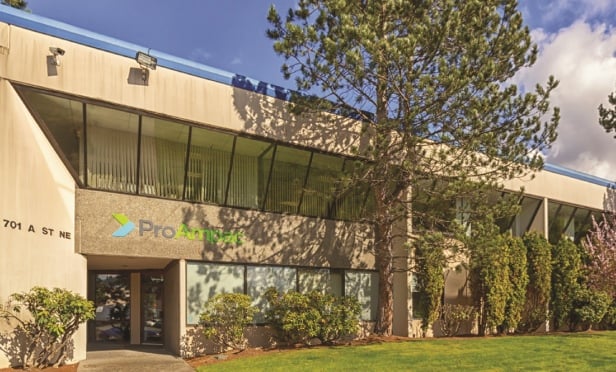
SAN FRANCISCO—Adam Aasen, vice president of Pacific Eagle Holdings Corporation, has completed more than $2 billion of real estate investment, development, equity and debt transactions across various real estate product types. He shares some insights into Pacific Eagle's commercial investment, acquisition and development, as well as capital market activities in this exclusive Q&A.
GlobeSt.com: What is Pacific Eagle's strategy for investment and acquisition?
Adam Aasen: In addition to seizing opportunities in tier one cities, Pacific Eagle has identified secondary growth markets across the country where there are plenty of opportunities to buy and build at a fraction of the cost. These markets provide strong, diversified economies, a higher quality of life and better value for residents, and because of that, companies are starting to expand or relocate to these areas. In terms of product type, our immediate focus is on existing, core-plus and value-add office and residential opportunities. Additionally, we are seeing attractive development opportunities for more patient entitlement plays, or next cycle deals.
GlobeSt.com: What are some of the recent Bay Area developments that give a good idea of your gameplan?
Aasen: We are bullish on the long-term prospects of San Francisco and have been focused on development in strategic neighborhoods. We're nearing completion of The Austin, a 100-unit residential condominium project in the Lower Polk neighborhood, a location that is seeing a lot of growth thanks to the Mid-Market reactivation and the extension of Union Street and North Beach. We've taken a modern approach to the amenities and hospitality services we offer, knowing future homeowners in the city will likely take advantage of the trend of flexible office hours. Our team also just unveiled the designs for 555 Howard, a luxury hotel and condominium tower designed by Renzo Piano, which would be directly across from the Transbay Terminal. And we're working on a project at 1125 Market, between 7th and 8th Streets, where we plan on developing a new lifestyle hotel.
GlobeSt.com: What product types are showing the most investor interest in the Bay Area?
Aasen: Pacific Eagle has been based in the Bay Area since 1992, so we've seen the market evolve and can really focus on where we see the most potential. Right now, this is in condo opportunities and hotel projects.
GlobeSt.com: What do you see on the horizon for Bay Area acquisitions and development that shows a positive trend?
Aasen: We're looking at the long-term potential of projects, focusing on the areas mentioned above and starting to move our focus away from office buildings, which we think is at or near peak pricing in the Bay Area. We spent last year in disposition mode, selling four of our Bay Area office projects, including two towers in the CBD. We'll ultimately look to rebuild our office portfolio, but at the moment, we're only looking at opportunities where we can effectuate change through heavy repositioning and/or re-tenanting.
GlobeSt.com: Any speedbumps in sight?
Aasen: The two principal concerns we have are: (1) where are we in the cycle and (2) the outlook and opportunity for future returns. We're especially cautious when factoring in current asset valuations, the limited deal flow coupled with increased allocations by domestic and foreign investors, and the overall volatility in the worldwide markets. However, that said, real estate will continue to present attractive risk-adjusted return opportunities. We'll just have to continue to be disciplined, especially in this crowded marketplace.

SAN FRANCISCO—Adam Aasen, vice president of Pacific Eagle Holdings Corporation, has completed more than $2 billion of real estate investment, development, equity and debt transactions across various real estate product types. He shares some insights into Pacific Eagle's commercial investment, acquisition and development, as well as capital market activities in this exclusive Q&A.
GlobeSt.com: What is Pacific Eagle's strategy for investment and acquisition?
Adam Aasen: In addition to seizing opportunities in tier one cities, Pacific Eagle has identified secondary growth markets across the country where there are plenty of opportunities to buy and build at a fraction of the cost. These markets provide strong, diversified economies, a higher quality of life and better value for residents, and because of that, companies are starting to expand or relocate to these areas. In terms of product type, our immediate focus is on existing, core-plus and value-add office and residential opportunities. Additionally, we are seeing attractive development opportunities for more patient entitlement plays, or next cycle deals.
GlobeSt.com: What are some of the recent Bay Area developments that give a good idea of your gameplan?
Aasen: We are bullish on the long-term prospects of San Francisco and have been focused on development in strategic neighborhoods. We're nearing completion of The Austin, a 100-unit residential condominium project in the Lower Polk neighborhood, a location that is seeing a lot of growth thanks to the Mid-Market reactivation and the extension of Union Street and North Beach. We've taken a modern approach to the amenities and hospitality services we offer, knowing future homeowners in the city will likely take advantage of the trend of flexible office hours. Our team also just unveiled the designs for 555 Howard, a luxury hotel and condominium tower designed by Renzo Piano, which would be directly across from the Transbay Terminal. And we're working on a project at 1125 Market, between 7th and 8th Streets, where we plan on developing a new lifestyle hotel.
GlobeSt.com: What product types are showing the most investor interest in the Bay Area?
Aasen: Pacific Eagle has been based in the Bay Area since 1992, so we've seen the market evolve and can really focus on where we see the most potential. Right now, this is in condo opportunities and hotel projects.
GlobeSt.com: What do you see on the horizon for Bay Area acquisitions and development that shows a positive trend?
Aasen: We're looking at the long-term potential of projects, focusing on the areas mentioned above and starting to move our focus away from office buildings, which we think is at or near peak pricing in the Bay Area. We spent last year in disposition mode, selling four of our Bay Area office projects, including two towers in the CBD. We'll ultimately look to rebuild our office portfolio, but at the moment, we're only looking at opportunities where we can effectuate change through heavy repositioning and/or re-tenanting.
GlobeSt.com: Any speedbumps in sight?
Aasen: The two principal concerns we have are: (1) where are we in the cycle and (2) the outlook and opportunity for future returns. We're especially cautious when factoring in current asset valuations, the limited deal flow coupled with increased allocations by domestic and foreign investors, and the overall volatility in the worldwide markets. However, that said, real estate will continue to present attractive risk-adjusted return opportunities. We'll just have to continue to be disciplined, especially in this crowded marketplace.
© 2025 ALM Global, LLC, All Rights Reserved. Request academic re-use from www.copyright.com. All other uses, submit a request to [email protected]. For more information visit Asset & Logo Licensing.









